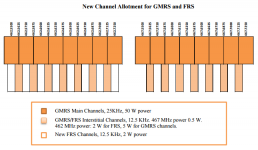Subpart B—Family Radio Service (FRS)
I feel it necessary to caution you: Programming FRS transmit frequencies into your radio is illegal. Actually transmitting on them is an FCC violation.
FCC Part 95 rules applicable to FRS and this discussion:
§ 95.501 Scope.
This subpart contains rules that apply only to the Family Radio Service (FRS).
§ 95.503 Definitions, FRS.
Family Radio Service (FRS). A short-distance two-way voice communication service, with limited data applications, between low power hand-held radios, for facilitating individual, family, group, recreational and business activities.
FRS unit. A transceiver for use in the FRS.
§ 95.561 FRS transmitter certification.
(a) Each FRS unit (a transmitter that operates or is intended to operate in the FRS) must be certficated for use in the FRS in accordance with this subpart and
subpart J of part 2 of this chapter.
(b) A grant of equipment certification for the FRS will not be issued for any FRS transmitter type that fails to comply with all of the applicable rules in this subpart.
(c) A grant of equipment certification will not be issued for hand-held portable radio units capable of operating under both this subpart (FRS) and under any other subparts of this chapter (except part 15) if the application for such grant is filed on or after December 27, 2017.
§ 95.567 FRS transmit power.
Each FRS transmitter type must be designed such that the effective radiated power (ERP) on channels 8 through 14 does not exceed 0.5 Watts and the ERP on channels 1 through 7 and 15 through 22 does not exceed 2.0 Watts.
§ 95.571 FRS emission types.
Each FRS transmitter type must be designed such that it can transmit only the following emission types: F3E, G3E, F2D, and G2D.
§ 95.573 FRS authorized bandwidth.
Each FRS transmitter type must be designed such that the occupied bandwidth does not exceed 12.5 kHz.
§ 95.587 FRS additional requirements.
Each FRS transmitter type must be designed to meet the following additional requirements.
(a) Transmit frequency capability. FRS transmitter types must not be capable of transmitting on any frequency or channel other than those listed in § 95.563.
(b) Antenna. The antenna of each FRS transmitter type must meet the following requirements.
(1) The antenna must be a non-removable integral part of the FRS transmitter type.
(2) The gain of the antenna must not exceed that of a half-wave dipole antenna.
(3) The antenna must be designed such that the electric field of the emitted waves is vertically polarized when the unit is operated in the normal orientation.


